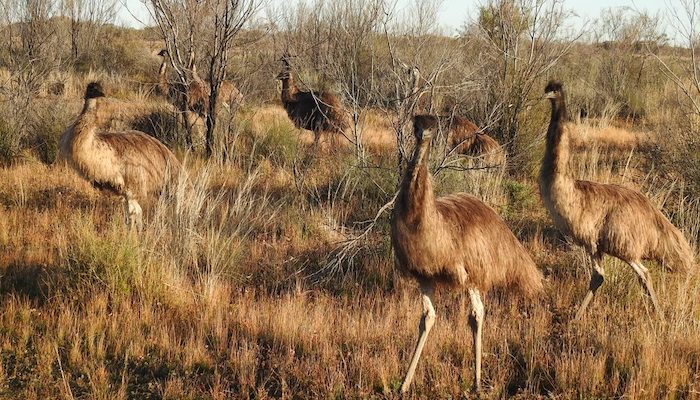North Coast NSW emus in dire need of a saviour

Plans to revive an endangered wild emu flock around the NSW Northern Rivers region will get a boost from an important genetic research project giving wildlife rescuers an evidence base for future breeding plans.
Less than 60 wild emus now remain around the region east of the 3500-kilometre Great Dividing Range, which has kept the population genetically isolated, mainly in the Yuraygir National Park, although they range widely.
“Emus are scattered across Australia, but our work explored the genetic interaction among emu populations in south-east Australia, including these coastal birds,” says Skye Davis, a Macquarie University PhD researcher leading the project.
The team found very low genetic variation among the Northern Rivers emu group, confirming suspicions that the group’s isolation from other emus over centuries means it now lacks the genetic diversity needed to adapt to ongoing environmental change.
“One way to rescue this population would be translocation, that is, introducing new individuals from other parts of its range to increase genetic diversity,” says Associate Professor Adam Stow who heads up Macquarie University’s Conservation Genetics Lab and is supervising the research.
The research shows that genetic replenishment isn’t happening naturally by migration, he adds.
Using DNA data for emu management plans
The important genetic data from this research will inform the design of management plans aimed at improving the long-term survival of the small Northern Rivers emu population, classified ‘endangered’ by the NSW government.
While emu sub-species extinctions happened after colonisation (in Tasmania, Kangaroo and King Islands), most Australian emus live in healthy-sized populations, preferring open grasslands and woodlands; and over a million emus living overseas include sizeable groups farmed for their oil, meat, leather and feathers in the US, Peru and China.
The Northern Rivers group’s endangered status won’t affect Australia’s national Common Emu (Dromaius novaehollandiae) population, of between 630,000 to 725,000 birds, assessed as ‘of least concern’ on the endangered species Red List produced by the International Union for Conservation of Nature and Natural Resources (IUCN).
“We analysed thousands of DNA markers from emu feathers and tissue samples, and found that the Northern Rivers group is genetically distinct from other groups in the species,” says Davis.
The Northern Rivers has likely hosted emu populations for thousands of years, but before colonisation they could move around far more freely.

Isolating the problem
“Our forecasts predict that without intervention, genetic variation will continue to decline resulting in further inbreeding, inbreeding depression, and even lower genetic variation,” Davis says.
Genetic isolation may have been worsened by changed land use and fire regimes in the area since colonial settlement, further isolating this group of emus from other populations via safe wildlife corridors.
Stow has seen the decline of the Northern Rivers emu flock in person.
“As a kid hanging around in Yuraygir National Park in the early to mid 80’s, I remember the emus were quite abundant,” he says, adding that the emus were even known to go swimming in the ocean, where they would occasionally flee to escape wild dogs.
Apart from dog attacks, and predation of eggs and chicks by foxes and feral pigs, the small group is also at risk from vehicles and habitat loss, so management plans may also include captive breeding – which comes with additional problems.
“We need to make sure the emus don’t become too accustomed to humans and that their natural behaviours are maintained,” says Davis.
Iconic emus
Australia’s iconic emu (named ngurihny by the Northern Rivers Bundjalung people) appears on Australia’s national coat of arms, in many important Indigenous stories and practices, and in more than 600 Australian place names.
Emus are highly adaptable flightless birds that are fast (clocked at up to 50 kilometres per hour), can travel great distances and survive on little food and water in a wide range of temperatures and habitats.
The notorious Emu Wars of 1932 saw the Australian army suffer a humiliating defeat when called in by grain farmers in Western Australia to deter thousands of crop-ravaging emus; despite tanks armed with two Lewis guns and 10,000 rounds of ammunition, the embattled emus ran in crazy circles and escaped, with just a few dozen killed.
Major Meredith, head of the unfortunate Seventh Heavy Battery of the Royal Australian Artillery tasked with the 1932 emu eradication, wrote at the time: “If we had a military division with the bullet-carrying capacity of these birds, it would face any army in the world… They can face machine guns with the invulnerability of tanks.”
Skye Davis says that while emus are incredibly resilient animals, genetic diversity is critical for survival, and the low numbers of the Northern Rivers flock could mean its demise.
“Rescuing this sub-species of emus has become an urgent conservation issue, and this research supports the next stage, of carefully introducing emus from other populations,” she says.
This article was first published on lighthouse.mq.edu.au, Macquarie University’s multi-media publishing platform.






